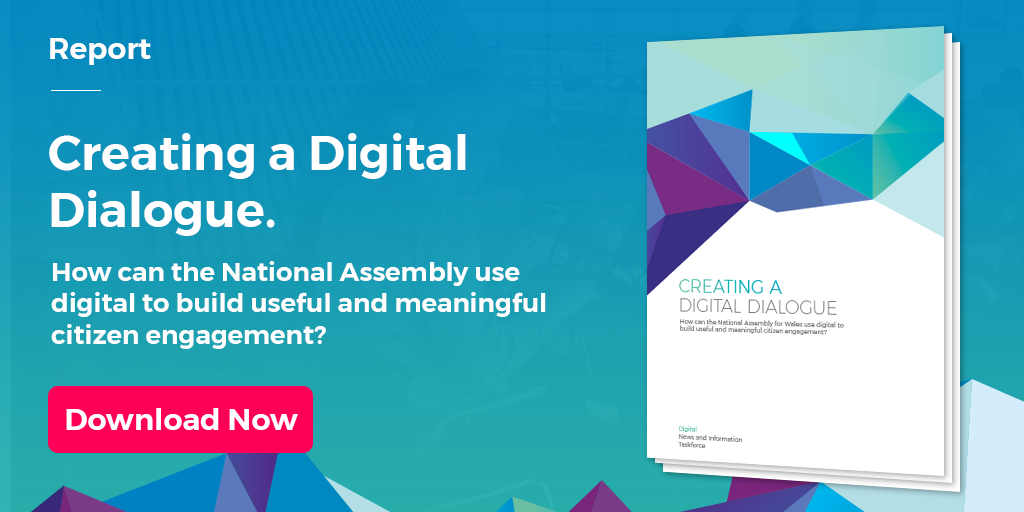Twenty years ago this September, the people of Wales voted in favour of having their own National Assembly.
It’s the only political institution the people of Wales have ever voted to have. Today we have published our report on how the National Assembly can deepen its relationship with the people of Wales through digital communications and social media. Our focus has been on the Welsh citizen – the potential user of the Assembly platform and services.
Our starting point is that all Assembly communications should be designed with a citizen/user interest at their heart, with a presumption of Open Data, seeking to build long-term relationships with the citizens of Wales.
In our report we set out how the National Assembly can use modern digital communication and social media channels to identify what people are thinking and concerned about, to collect evidence, information and opinion, and to engage in real-time with people in local communities and communities of interest.
The same media can then allow the Assembly to share with citizens directly how their elected representatives, individually and collectively, are seeking to respond to those issues.
Our proposals in some areas are radical.
We want the Assembly, its Members and staff, to understand that they are content creators: the Assembly is a content platform which captures facts, information, data, commentary, opinion, and analysis, both written and audiovisual, that leads – or sometimes consciously doesn’t lead – to action.
Our focus has been on the Welsh citizen – the potential user of the Assembly platform and services.
Our starting point is that all Assembly communications should be designed with a citizen/user interest at their heart, with a presumption of Open Data, seeking to build long-term relationships with the citizens of Wales.
In our report we set out how the National Assembly can use modern digital communication and social media channels to identify what people are thinking and concerned about, to collect evidence, information and opinion, and to engage in real-time with people in local communities and communities of interest.
The same media can then allow the Assembly to share with citizens directly how their elected representatives, individually and collectively, are seeking to respond to those issues.
Our proposals in some areas are radical.
We want the Assembly, its Members and staff, to understand that they are content creators: the Assembly is a content platform which captures facts, information, data, commentary, opinion, and analysis, both written and audiovisual, that leads – or sometimes consciously doesn’t lead – to action.

Pic: Senedd Lab (Hack Day), exploring how digital innovation could improve the way the Assembly engages with the public.
Properly organised, this is a profound, valuable and democratic digital space which reflects the nation’s conversations about the issues which are of most concern to it. It should be innovative, creative, and inspirational. Our group contained people with a diverse range of relevant skills, including the media, education, digital content and social media developments, which has enabled us to make practical proposals for improving the Assembly’s operations.Our recommendations are diverse.
They include these suggestions:- The Assembly should lead the way and establish an integrated content service using social media and other channels (such as dedicated email newsletters) to engage directly with the people of Wales.
- The Assembly should put people - rather than the institution and its processes - at the heart of topical news stories and aim for an emotional connection.
- The Assembly should create content that helps people understand the connections, differences and working relationships between the Assembly and other key organisations in Welsh public life to address the democratic information deficit.
- Senedd TV must be more user-friendly, with a simple tool allowing anyone to quickly find and clip footage which can be included in video packages or embedded on Member pages, external websites and social media platforms.
- Smart social media analytics should be adopted to identify online conversations and communities, and allow the Assembly to become involved in these discussions.
- The Assembly must exploit every alternative to the press release as a means of promoting its work. Maps, infographics, blogs and neat summaries all have the potential to articulate difficult messaging in a memorable way.
- A dedicated, easy to use National Assembly for Wales area should be established on the Hwb resource repository with resources for teaching that are mapped to the needs of the new curriculum currently being developed.
- The Assembly should establish strong contacts with Welsh Higher and Further Education Institutions to facilitate easier engagement with the Senedd and explore the potential of developing a MOOC (Massive Open Online Course) about its work.
- Social media platforms best suited to engage with young people and learners should be adopted, in line with current trends. The Assembly should embrace the potential for digital engagement utilising other platforms such as Skype, Facetime, Virtual Reality or Augmented Reality.
- Further thought should be given to the visitor experience at the Senedd and the Pierhead, including the use of projection, video walls, Virtual and Augmented Reality on the estate, inside and outside the Senedd and Pierhead.
 In voting for a National Assembly twenty years ago, the people of Wales created a new democratic institution operating, it is fair to say, in a fragmented public sphere.
Though the National Assembly was born at the time of digital developments in our media, in practice we built a new Welsh public polity in the absence of a coherent Welsh public sphere. It was not our job as a group to consider the Welsh media and its structural challenges – committees of the Assembly have been looking at those themselves.
Our task was to help the National Assembly establish how best to build a deep, genuine and continuous dialogue with the people of Wales.
This is our report. Let the debates begin!
In voting for a National Assembly twenty years ago, the people of Wales created a new democratic institution operating, it is fair to say, in a fragmented public sphere.
Though the National Assembly was born at the time of digital developments in our media, in practice we built a new Welsh public polity in the absence of a coherent Welsh public sphere. It was not our job as a group to consider the Welsh media and its structural challenges – committees of the Assembly have been looking at those themselves.
Our task was to help the National Assembly establish how best to build a deep, genuine and continuous dialogue with the people of Wales.
This is our report. Let the debates begin!


